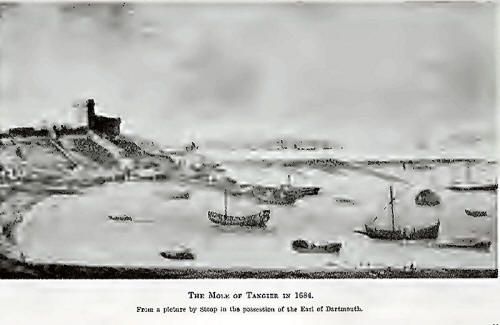NOTE BY THE EARL OF DARTMOUTH, K.C.B., ON
THE PICTURE AT PATSHULL HOUSE REPRESENTING PARADE OF TROOPS AT TANGIER
IN 1683
The picture represents an incident described in the History of the
Grenadier Guards, vol. i., p. 259, and is referred to in the Dartmouth
Papers {Hist. MSS. Commission), vol. i., p. 94.
It took place on 26th September 1683, or on the following day.
"Lord Dartmouth was requested by the Alcade (the leader of the Moors) to
grant him a personal interview, whereupon the new governor took the
opportunity of drawing out all the available troops of the garrison, and
in order to make a still greater impression upon the Moor, he took
advantage of the recent arrival of new clothing for the Scots and
Trelawny’s regiments to dress up his seamen in red coats, and paraded
upwards of 4000 men in line in addition to leaving strong guards at
other posts. The line of troops extended from Pole’s Fort on the right
to Fountain’s Fort on the left, while the seamen about 1000 strong—drew
up from thence along the sands by the seaside.”
In the picture Lord Dartmouth's own battalion of seamen—200 strong —
“clothed in white and blue striped linen, and with four Union flags,”
are on the right of the line on the sands (Dartmouth Papers).
Next to them stand “two other battalions of 200 men each," clothed with
such clothes as the Scots shall furnish, with eight colours of Colonel
Trelawny’s Regiment (Dartmouth Papers).
These Irish colours are St George's Cross “ fimbriated" with a white
edging on a blue ground, and appear to be exactly similar to the colours
of the Coldstream Guards at that date.
The whole of the seamen were under the command of Sir John Berry.

Lord Dartmouth himself seems to be
viewing the Alcade—behind him is an escort of the Tangier Horse, now the
1st Royal Dragoons. Their guidon is crimson charged with the Royal
Crown. On their return home the Royal cipher was added below the Crown
to the Colonel's colour.
On the left of the picture is the garrison of Tangier. First comes a
composite regiment of five companies called “the King’s Battalion.” It
was originally composed of two companies of the King's Regiment of
Guards, and one company of the Coldstream Regiment with two companies
from Portsmouth, Plymouth, the Tower, and the Isle of Wight. Two colours
were issued to the two companies of the 1st Guards, the Red Cross of St
George on a white ground, with a royal badge on each colour and one blue
colour with St George's Cross fimbriated white to the Coldstream
company, in June 1680, when they left England.
In the picture there appears to be only one colour of the 1st Guards and
four of the Coldstream ones. Renewals may have taken place in the
interval.
The battalion next in line has eight colours (or four?): St George’s
Cross fimbriated white, with three white rays issuing from each corner
of the Cross, on a dark green field, and is, therefore, Colonel Kirke’s
Regiment (now the Queen’s), as these colours correspond to the
description given of them by one, Nathan Brooks, who published an
account of a review held at Putney Heath the following year, when this
regiment and the others in the picture were present.
Next to them, coming down the hill, are the Royal Scots, with eight
colours, the Colonel's colour white, the other seven St Andrew's Cross,
white on a blue ground. Each of these colours had a golden thistle and
crown, with the motto “Neino me impune lacessit” in gold letters round
the thistle,
On the left of the line Sir John Berry's battalion “clothed with the
colours Mr Hewers shall give, with four Irish colours” (Dartmouth
Papers). on the centre of the Cross; but the picture is on too small a
scale to show this. It does look, however, as if the Colonel’s white
colour had gold splotches on it.
In the fort is the third battalion — which is Trelawny's (now the King's
Own).
There are eight colours, one plain red, the Colonel's, the others of the
same character as the others.
The Dartmouth Papers describe the seamen as carrying the colours of
Trelawny’s Regiment, so probably new colours were sent out to replace
the old ones, and the ones so carried answer to Nathan Brook’s
description of the colours of the regiment in 1684 when it became H.R.H.
the Duchess of ¥ork and Albany’s Regiment of Foot, viz., St George's
Cross fimbriated on a yellow ground, with rays issuing from the centre
of the Cross. Perhaps it was on account of the change of name that new
colours were sent out, but they look much the same as those in the fort,
except for the red Colonel’s colour.
It is noticeable that the battalions of soldiers have the pike men in
the centre and musketeers on the Hanks, while the seamen’s battalions
have no pike men.
The details of the picture seem amazingly accurate.
The King's battalion on its return was made into additional Grenadier
companies for the Guards at Lord Dartmouth's suggestion—one to each
regiment. |

